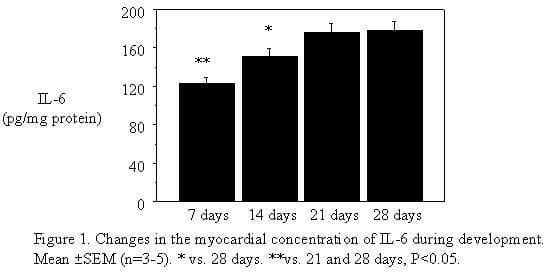The pro-inflammatory cytokine interleukin-6 (IL-6) has been implicated in tissue (e.g. cardiac and lung) damage following ischaemia and reperfusion (Benson et al. 2003; Chiang et al. 2001; Teng et al. 2004). Whether this increase contributes to injury or is a consequence of injury remains unresolved. The vulnerability of the myocardium to ischaemia and reperfusion changes during development (Ostadal et al. 1999). For example, we have shown that the extent of reperfusion damage changes during different stages of development with 14 day old hearts showing more resistance compared with 7 and 21 day old hearts (Modi & Suleiman, 2004). In the present study we investigated whether these differences are related to the basal level of myocardial IL-6 in different age groups. Male wistar rats (7, 14, 21 and 28 days old) were humanely killed, and the hearts were removed and rinsed in ice-cold buffer. Ventricular cardiac tissue was snap frozen in liquid nitrogen and processed for determination of total protein content and IL-6 content. Enzyme-linked immunosorbent assay was used to measure the concentration of IL-6 protein in heart tissue. All results are expressed means ± S.E.M. and analysed using ANOVA with Fischer’s PLSD post hoc test. Figure 1 shows that the concentration of IL-6 in rat hearts changes during different stages of development. IL-6 levels were lowest in 7 day old hearts but increased with age reaching maximum at 21 days. Whether these differences in the basal level of IL6 contribute to protection against reperfusion injury during development requires further investigation.
University of Bristol (2005) J Physiol 567P, PC19
Poster Communications: Age-related differences in rat cardiac interleukin-6: implications for vulnerability to reperfusion injury
Moore, Elizabeth K; Chase, Anabelle; Lin, Hua; King, Nicola; Suleiman, M. Saadeh;
1. Bristol Heart Institute, University of Bristol, Bristol, United Kingdom. 2. Department of Physiology, University of Bristol, Bristol, United Kingdom.
View other abstracts by:
Figure 1.
Where applicable, experiments conform with Society ethical requirements.

